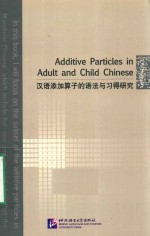图书介绍
汉语添加算子的语法与习得研究PDF|Epub|txt|kindle电子书版本下载

- 高慧娟著 著
- 出版社: 北京:北京语言大学出版社
- ISBN:9787561942550
- 出版时间:2015
- 标注页数:320页
- 文件大小:45MB
- 文件页数:338页
- 主题词:汉语-语法-研究-英文
PDF下载
下载说明
汉语添加算子的语法与习得研究PDF格式电子书版下载
下载的文件为RAR压缩包。需要使用解压软件进行解压得到PDF格式图书。建议使用BT下载工具Free Download Manager进行下载,简称FDM(免费,没有广告,支持多平台)。本站资源全部打包为BT种子。所以需要使用专业的BT下载软件进行下载。如BitComet qBittorrent uTorrent等BT下载工具。迅雷目前由于本站不是热门资源。不推荐使用!后期资源热门了。安装了迅雷也可以迅雷进行下载!
(文件页数 要大于 标注页数,上中下等多册电子书除外)
注意:本站所有压缩包均有解压码: 点击下载压缩包解压工具
图书目录
Chapter 1 Overview and Background1
1.1 Overview1
1.2 General Review of Focus Particles and Additive Particles2
1.2.1 Focus Particles and Focalization2
1.2.2 Additive Particles4
1.3 Theoretical Assumptions4
1.3.1 Altemative Semantics4
1.3.2 Tripartite Structures7
1.3.3 Eventuality Types10
1.4 Problems ofAdditive Particles in Mandarin12
1.4.1 Types of Mandarin Additive Particles and Their Interaction with Focus12
1.4.2 Research Issues14
1.5 Structure ofthe Book16
Chapter 2 Additive Particle Ye:Focus,Scope and Presupposition18
2.1 Introduction18
2.2 Previous Studies and the Research Issues18
2.2.1 Obligatory Conditions of Too19
2.2.2 Too's Contribution to the Host Sentence23
2.2.3 Presupposition of Too24
2.3 Variants of Ye and Their Scope25
2.3.1 Ye with a Following Focus26
2.3.1.1 YeF as a Focus Particle27
2.3.1.2 Interaction of YeF with Other Focus Particles28
2.3.1.3 Obligatory and One-distinct Requirement of YeF29
2.3.2 Stressed Ye32
2.3.2.1 Stressed Ye as a Scope Particle34
2.3.2.2 Interaction of Stressed Ye with Other Particles35
2.3.2.3 One-distinction Requirement36
2.3.3 Ye with a Preceding Focus/Topic38
2.3.3.1 Pye as a Focus Particle39
2.3.3.2 TheInteractionofPye andOtherParticles40
2.3.3.3 One-distinction Requirement41
2.3.3.4 Lian...Ye42
2.3.4 Summary45
2.4 Presupposition of Ye45
2.4.1 Problems ofthe Presupposition of Too46
2.4.2 Solutions to the Problems in Literature46
2.4.3 Our Proposal49
2.5 Conclusion50
Chapter 3 Additive Particle Hai:Scope,Focus and Presupposition51
3.1 Introduction51
3.2 Literature Review51
3.2.1 Meaning Components of Still/Noch52
3.2.1.1 Temporal Still/Noch53
3.2.1.2 Marginality Still/Noch57
3.2.2 Main Theories concerning Still/Noch57
3.2.2.1 The Unified-meaning Approach57
3.2.2.2 Multiple-meaning Analysis61
3.2.3 Previous Analysis of Hai64
3.2.3.1 Multiple-meaning Account64
3.2.3.2 Unified Account of Hai74
3.2.3.3 Other Literature on Hai79
3.3 Variants of Hai79
3.3.1 Stressed Hai as an Increment Degree Operator80
3.3.1.1 Puzzles Related with Stressed Hai80
3.3.1.2 Our Proposal:Stressed Hai as an Increment Operator96
3.3.1.3 Summary106
3.3.2 Hai with a Following Focus:Default Focus Structure107
3.3.2.1 Haiyou108
3.3.2.2 Haishi110
3.3.2.3 Summary of HaiF111
3.3.3 Hai with a Preceding Focus:Scalar Additive and Pure Addition111
3.3.3.1 Previous Analysis ofAdditive Scalar Particles113
3.3.3.2 Distribution ofEven Words in Mandarin114
3.4 Semantics of Hai117
3.5 Presupposition of Hai118
3.6 Conclusion119
Chapter 4 Additive Particle You:Scope,Focus and Presupposition121
4.1 Introduction121
4.2 Literature Review121
4.2 1 Previous Studies on Again/Wieder122
4.2.1.1 The Repetitive vs.Restitutive Reading of Again/Wieder122
4.2.1.2 Reductionism vs.Polysemous Account125
4.2.1.3 The Presupposition of Again/Wieder126
4.2.2 Accounts of Chinese You129
4.2.2.1 You in Classical Grammar Book130
4.2.2.2 Accounts of You from Different Aspects131
4.3 The Semantics of You141
4.3.1 Stressed You142
4.3.1.1 Temporal Clauses142
4.3.1.2 Amount Additive Use ofStressed You156
4.3.1.3 Multiple-repetition Structure158
4.3.1.4 Issues concerning the Presuppositions of Stressed You160
4.3.2 You with a Following Focus169
4.3.2.1 Relations between the Asserted and Presupposed Sentences of You with a Following Focus170
4.3.2.2 Presuppositions ofUnstressed You with a Following Focus174
4.3.3 You with a Preceding Focus180
4.3.3.1 The Additive Meaning180
4.3.3.2 The Contrastive Meaning181
4.3.3.3 The Scalar Meaning183
4 3 4 Conclusion188
Chapter 5 System of Mandarin Additive Particles190
5.1 Introduction190
5.2 Stressed Focus Particles190
5.2.1 Stressed Ye192
5.2.2 Stressed Hai193
5.2.3 Stressed You194
5.2.4 System ofStressed Additive Particles195
5.3 Mandarin Additive Particles with a Following Focus196
5.4 Mandarin Additive Particles with a Preceding Focus199
5.5 System ofMandarin Additive Particles202
Chapter 6 Overview of the Acquisition of Additive Particles204
6.1 Introduction204
6.2 Previous Studies205
6.2.1 The Experimental Studies of the Acquisition of Additive Particles206
6.2.1.1 Hüttner et al.(2004)207
6.2.1.2 Bergsma(2006)209
6.2.1.3 Matsuoka(2004,2006)213
6.2.2 The Longitudinal Studies of the Acquisition of Additive Particles214
6.2.2.1 Nederstigt(2003,2006)215
6.2.2.2 Lee(2002,2005)218
6.2.3 The Acquisition ofRestrictive Operators221
6.2.4 Acquisition of Prosody223
6.3 Relevant Issues in the Current Study225
Chapter 7 Production of Mandarin Additive Particles in Child Language227
7.1 Introduction227
7.2 Facts of Additive Particles in Mandarin Chinese229
7.2.1 Phonological Properties and Syntactic Positions of Mandarin Additive Particles229
7.2.2 Semantic Components of Mandarin Additive Particles231
7.2.3 Pragmatics of Additive Particles232
7.2.4 Children's Learning Tasks of Mandarin Additive Particles232
7.3 Universality233
7.4 Methodology234
7.5 Production ofStressed Ye236
7.5.1 Materials and Procedures236
7.5.1.1 Picture Description237
7.5.1.2 Game Play239
7.5.2 Participants239
7.5.3 Results239
7.6 Production of Stressed Hai241
7.6.1 Materials and Procedures241
7.6.1.1 Truth-value Judgment241
7.6.1.2 Game Play243
7.6.2 Participants243
7.6.3 Results243
7.7 Production of Stressed You244
7.7.1 Materials and Procedures244
7.7.1.1 Video Description245
7.7.1.2 Game Play246
7.7.2 Participants246
7.7.3 Results246
7.8 Production of Unstressed Hai/Ye/You247
7.8.1 Materials and Procedures247
7.8.1.1 Picture Description and Truth-value Judgment247
7.8.1.2 Video Description:Unstressed You249
7.8.1.3 Game Play249
7.8.2 Participants250
7.8.3 Results250
7.8.3.1 Results of Unstressed Hai/Ye250
7.8.3.2 Results of Unstressed You252
7.9 Discussion and Conclusion253
7.9.1 Overall Results of the Production ofAdditive Particles in Mandarin253
7.9.2 General Discussion254
7.9.2.1 Linguistic Knowledge Children Should Know to Produce Additive Particles254
7.9.2.2 Early Emergence257
7.9.2.3 Lack of Decisive Evidence in the Environment258
7.9.2.4 Universality258
7.9.3 Conclusion258
Chapter 8 Comprehension of Mandarin Additive Particles in Child Language258
8.1 Introduction260
8.2 Methodology260
8.3 Comprehension of Stressed Ye261
8.3.1 The Basics of Stressed Ye261
8.3.2 Materials and Procedures263
8.3.3 Participants265
8.3.4 Results266
8.3.4.1 Group Results266
8.3.4.2 Individual Results267
8.4 Comprehension of Stressed Hai269
8.4.1 The Basics of Stressed hai269
8.4.2 Materials and Procedures270
8.4.2.1 Truth-value Judgment Task270
8.4.2.2 Act-out Task273
8.4.3 Participants273
8.4.4 Results274
8.4.4.1 Overall Performance274
8.5 Comprehension of Stressed You275
8.5.1 The Basics of Stressed You275
8.5.2 Materials and Procedures276
8.5.3 Participants279
8.5.4 Results279
8.6 Comprehension of Unstressed Hai280
8.6.1 The Basics of Unstressed Hai280
8.6.2 Materials and Procedures281
8.6.3 Participants283
8.6.4 Results283
8.6.4.1 Group Results284
8.6.4.2 Individual Results285
8.7 Discussion and Conclusion286
8.7.1 Possible Explanations of Production-Comprehension Asymmetry287
8.7.1.1 Difficulty in Interpreting Subject Focus287
8.7.1.2 Marked Focus Structures291
8.7.2 The Analysis:Failure of Accommodating Presuppositions292
8.7.2.1 Acquisition of Presuppositions292
8.7.2.2 Failure of Accommodating Presuppositions in Comprehension ofAdditive Particles293
Chapter 9 Conclusions and Outlook295
9.1 Main Claims and Results295
9.1.1 Theories of Mandarin Additive Particles295
9.1.2 Results of the Acquisition of Mandarin Additive Particles298
9.2 Future Work299
Appendices301
References304